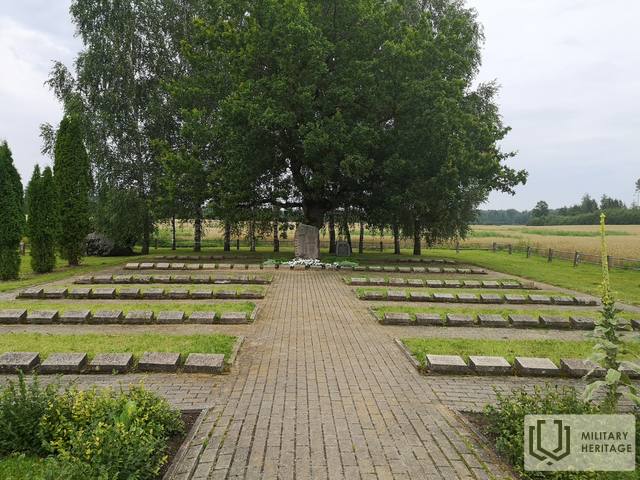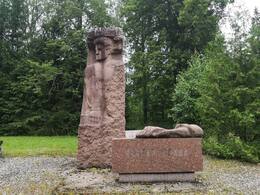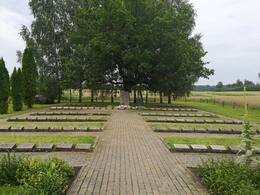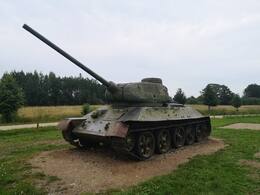Unrecognized Soldiers. The Story of a Combat Officer.
The Battle of More is an episode of the final stage of World War II, which had a great importance in the further course of the war in the territory of Latvia. The Battle of More refers to the hostilities that took place from September 25 to October 5, 1944, on the Sigulda Defense Line in the territory of More parish. In the trenches of the Sigulda Defense Line, approximately 12 km long, soldiers of the 19th Division of the Latvian Legion, fighting heavy battles with a 10 to 15-fold superiority of the enemy for 10 days, stopped the advance of the Red / Soviet Army units towards Riga.
“In July 2001, a Bundeswehr major and his entourage visited Mori. The main interest was in the tactics of World War II. According to military history, one of the most famous Russian divisions, commanded by General Shatilov, attacked the 19th Latvian Grenadier Division at Mori. The soldiers of this division were very well trained and used German offensive tactics. At Mori, they were defeated, and this aroused interest among the Germans. The main issues discussed were precisely combat tactics. As German officers, they heard about some aspects for the first time, which means that they had lost a lot from World War II. For example, the fact that during the Battle of Mori, the company command post was not traditionally located on the first battle line, as the German school teaches, was new to them. Anti-tank guns justified themselves as a defensive weapon, being located on the first battle line. The Russians used anti-tank weapons in the attack, involving them in the first echelon, but the Germans "The forces used this tactical solution from the very beginning of the war. It was nothing new to them. The Mori were also visited by participants of the Second World War – men from General Steiner's tank corps, from the tank division "Wiking", from the tank grenadier division "Gotz von Berlichingen" and others. And there was always an interest in tactical issues."
Rolands Konvtunenko “Unsung Soldiers. The Story of a Combat Officer”. R: Aplis. 2004.
Related timeline
Related objects
Mores Battle Memorial Park
The park was created in the former battle place in the Centre of More Parish where during the first two weeks of 1944 in the Second World War, major battles were held, holding thestrategically created defence line and preventing the Red Army from breaking through to Riga, thus affecting the further course of history.
You can see fragments of wartime relics and bunker sites here. A commemorative stone created by the sculptor H. Sprincis, as well as a Memorial Plaque with 186 soldiers names carved into the granite, are located in the Battles of More Memorial Park.
Red Army Brethren Cemetery in More
The Red Army Military Cemetery is located on the side of the main road through More. It is the final resting place for approximately 2000 soldiers who were killed during the Battle of More. In 1974 the cemetery was landscaped and a monument by sculptor B. Grīsle was unveiled.
Museum of Battles in More
The museum is located in More, on the side of the V319 motorway. It is dedicated to the Battles of More between the Red Army and the Latvian Legion of the German Army in the autumn of 1944. The exhibit includes a mock-up of the battlefield, weapons, awards, soldiers’ uniforms and military equipment. The Battles of More Museum and Memorial Park was established by former soldiers of the Latvian Legion who participated in the Battles of More. The memorial park features trenches, dugouts and battlefields. The battles in the More area were only part of a large-scale operation of the Red Army Baltic Offensive involving a total of 900,000 soldiers and large numbers of military equipment units. A part of the German Army fortification system where Latvian legionnaires prevented the Red Army’s attempt to break out to Riga was located in the vicinity of More. This allowed the German Army to withdraw its forces from Estonia and avoid defeat. Red Army leaders expected the enemy’s resistance near More to be short-lived and stubbornly continued its unprepared and uncoordinated attacks, suffering heavy losses. Local advantages and the combat capabilities of the Latvian legionnaires played a significant role in the subsequent course of the war. More is home to the Latvian Legionnaires’ Brothers’ Cemetery and a Red Army Soldiers’ Cemetery.










